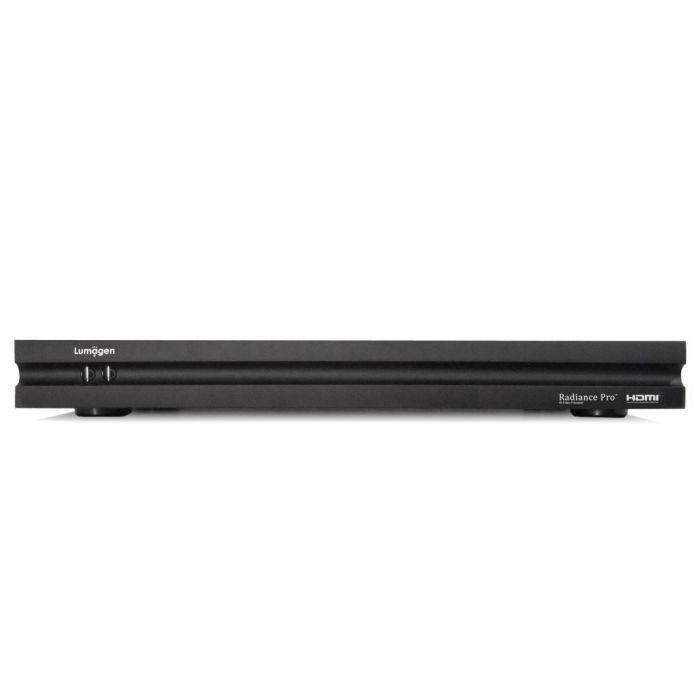Lumagen Radiance Pro 5348
If you have any questions about this article, just contact our customer service.
Info Hotline:
If you can not reach us by phone, just use our contact form:Lumagen Radiance Pro 5348
The 5348 takes the ultimate video processor to the next level by minimizing output-jitter and electrical noise.
The Radiance Pro 5348 has ten 18 GHz inputs, two 18 GHz outputs, and one audio-only output, in a 1U case. This is a fixed configuration.
The Radiance Pro 5348 uses the same software as the 4XXX models. So, video processing operations are currently identical. What sets the Radiance Pro 5348 apart is the electrical improvements in the design. While using the same HDMI chips, and FPGA, the use of linear regulators for 28 critical power supplies, and the addition of an HDMI dejitter output buffer, has dramatically reduced output jitter and noise. The use of Faraday cages for all nine DC-to-DC switching-regulators dramatically reduces EMI.
As an example, the current 18 GHz Rev 1.4 output card in a 4446 has a HDMI data jitter of about 80 pS (HDMI specification requires 102 pS or less for 18 GHz). In comparison the measured HDMI output data jitter on the Radiance Pro 5348 is 45 pS, or just about half. More importantly for audio, the HDMI output clock jitter has been measured at about 10 pS. This is a nearly ideal clock to send to the audio processor.
People have asked me if reduced jitter and electrical noise matters. Yes, it does. I have been discussing HDMI jitter on the forums for many years. What I can say based on my A-to-B testing is that, with the Lumagen Demo Theater’s Trinnov Altitude 16, the Radiance Pro 5348 does make a significant improvement for appropriate content (e.g. Greatest Showman “Never Enough”). For the current 444X products I get calls on a fairly regular basis asking “the Radiance Pro does not process audio. So how come audio sounds better when it is running through the Radiance Pro?” The difference is lower jitter and reduced electrical noise. The Radiance Pro 4XXX output jitter and electrical noise are already dramatically better than other products we know about, but 5348 takes jitter and noise reduction to what we consider is the ultimate audiophile level.
Some have said that a high-end audio processor’s dejitter circuit can handle higher jitter levels. In my experience, audio processor dejitter circuits can improve the jitter as the signal works toward the DAC’s, but there is a limit to the improvement. The advantage the Radiance Pro has compared to traditional dejitter circuits is it completely regenerates the HDMI audio output using a very low jitter crystal clock chip for the HDMI audio clock, and then passes the HDMI signal through two stages of PLL dejitter circuits. Using linear power supplies also helps keep the jitter low by isolating the noise from the digital circuits away from the HDMI integrated circuits.
I am also being asked if the lower jitter of the 5348 will improve video. Since the 4XXX series already has output jitter well below specification, the 5348 going from 80 pS down to 45 pS for the data is not likely going to improve the Bit-Error-Rate (BER) on the HDMI connection. The data reaching the projector/TV should be identical and so there should not be any visible difference.
But, what about the reduced electrical noise on the Radiance Pro 5348 output? This gets into the question of can electrical noise injected into a projector through the HDMI cable affect the image’s background “analog” noise. For a digital display technology such as DLP, the answer in my opinion is no. For a projector with an underlying analog display chip technology (LCOS, DiLA) the answer is that there is a chance it might make a visible improvement. Each system needs to be evaluated individually to determine if there is any visible change. As with any image quality analysis, the final assessment must be done at viewing distance (typically 1X screen width for 4k). If you cannot see a noise reduction at viewing distance, any improvement is moot.
We have customers who say they can see a visible improvement due to lower noise using an external linear power supply and I believe I saw a slight image improvement (lower background noise) using the 5348 versus the 4446 in the Lumagen Demo Theater RS4500 with the supplied Radiance Pro external digital power supply. These difference are small, and unlike the audio where I am convinced I could tell the difference in a blind test, for video the difference would be difficult to tell which technology is in play in a blind test (IMO). So, we are not claiming you will see a visible improvement on an analog projector chip such as used by Sony and JVC. However, I believe I did see an improvement, and you can test this for yourself, assuming you have both a 4XXX and a 5348. I admit this may be hard to accomplish for most people.
The Radiance Pro 5348 uses a HDMI PLL re-clocking chip on each of the three outputs. We believe this HDMI buffer integrated circuit has slightly slower output edge rates that will be more forgiving when used with projectors with marginal HDMI input designs. These chips reduce jitter, and edge rate, but they also give the 5348 control of the output signal for level and EQ. Note that the default for the 5348 is to not have output EQ. The 4XXX series always have output EQ.
In the Lumagen demo theater all supported combinations of 5348 level and EQ work well. Not having EQ is intended to assist active fiber cables which do not have the appropriate amount of attenuation in their input buffers to account for the fact that normal HDMI outputs have cable EQ. This EQ typically in HDMI outputs, and the output edge rate, must be attenuated by a cable, or a well-designed input buffer in the case of the active fiber cable. With the default “no EQ” setting a passive cable should be in the 2-meter to 3-meter length range.

We have the Radiance Pro video processor available for demonstration in our home cinema studios in Berlin-Kreuzberg. We look forward to your visit!

